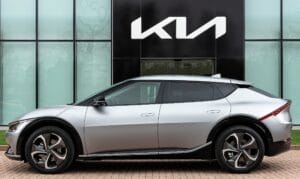Kia’s EV6 girds its loins for a championship battle with Tesla

Be under zero illusion, suggests Iain Robertson, while Tesla may have set a standard for the electric vehicle market that has been all but attainable by the rest of the industry, Kia is showing its hand and wants clearly to give Elon Musk a bloody nose.
Leaf through any of the motoring comics that nobody actually buys anymore and you may have spotted innumerable editorial headline claims that one brand, or another, was about to wrest the EV crown from Tesla’s cranium. Around three years ago, one of the nation’s esteemed weekly titles had the temerity to suggest that the Jaguar i-Pace was the first true Tesla rival. It was comprehensively wide of the mark in the keynote areas of mileage range and outright performance potential, even though the otherwise respectable Midlander was markedly cheaper.
Another of the journals proposed that the Volvo-related Polestar had its Sino-Swedish dukes ready for action, failing to observe that its self-imposed top whack restriction would be its primary limiting factor, supported by its lack of range, even though pricing was almost on a Tesla par. Considering that Tesla was fresh to market and vehemently not a carmaker by all traditional senses, I believe that it has made a pretty good fist of things, with svelte styling and an unusual approach to user practicality, primarily because it possesses almost zero manufacturing history and thus related headaches and bad baggage have no psychological weight.
Face it, Jaguar is scared of its own shadow that hangs like a harbinger of duff management decisions, while Polestar wants to emulate Tesla but harbours too close a relationship to Volvo, even though its Chinese masters, themselves relatively new to the business, think that loosening the reins should enable greater flexibility. In fact, when Tesla switches on its ‘Ludicrous’ mode, it can put paid to 99% of its electric hypercar rivals, produced from ‘unobtainium’ and priced for squillionaires.
Yet, Kia has been ferreting away in full vision, readying itself for the brave new world of electrification but approaching the market from a series of oddball angles. Its new EV6 model, for which orders are already being taken for early deliveries this autumn, is already promising a 328mls range for its 77.4kWh long range variant, which is the standard offering for the UK market, and Kia is not exactly renowned for making spurious claims.
However, its recharging experience is a virtual revelation, with a stop at an Ionity 800kW rapidcharger whacking it from 10-80% capacity in a mere 18mins (which contrasts starkly with a more average 35mins) and its internal box of tricks, should it stop at a 400kW fastcharger, namely its inverter, enabling it to double its charge rate for an identical performance. Yet, it is not finished there, as its bi-directional battery also allows the EV6 owner to recharge domestic appliances and other EVs. More vitally, it offers a towing capacity of 1.6tonnes, which smashes to smithereens the preconception of EVs being incapable of hauling caravans.
While Tesla has majored on space utilisation, the EV6’s cabin runs it very close for both interior space and functionality. The driver is fronted by a lean, minimalist dashboard architecture that emphasises the space less confusingly than the Tesla. The flat floor construction provides rear seat occupants with a whopping metre (3’ 3”) of leg room. Seconds out; Round Two!
A compact HVAC (heating, ventilation and aircon) system reduces the dimensions of the hardware by 55% without detriment to optimal cooling performance. Between the front seats a storage tray provides an useful space for small bags and tablets, while an integrated wireless charging pad enables users to charge devices with ease. The glovebox is larger thanks to the HVAC architecture, with a massive 10.5-litres of available space. Both front and rear drinks holders augment storage potential. While cabin space has been optimised, so, too, has the boot area, with a substantial 520-litres available, when the rear seats are in use. However, fold down the 60:40-split second row and the carrying capacity increases to 1,300-litres. While nowhere near as huge as the ‘frunk’ on the Tesla, that of the EV6 offers a more practical 52-litres (rear-wheel drive), or 20-litres (all-wheel drive models) and, thus, some essential space for the multi-functional plug-in and the recharging cables.
On the creature comfort front, Kia has installed special relaxation seats that allow the driver and front passenger to relax in reclined comfort, when the EV6 is parked, or being recharged. At the touch of a button, they lift and recline, cleverly optimising posture and body pressure distribution, while allowing occupants to stretch out, read a book, or grab 20 winks. Their lightweight, slim-line style supports the EV6’s interior practicality.
While Kia’s aim is to demonstrate its attitude towards sustainability, the materials used throughout the EV6’s cabin provide a welcoming but durable feel. The seats are clad in vegan leather as an option, while seat fabrics and floor carpets are made using recycled plastics, equivalent to 100 x 500ml plastic water bottles per car. It is an important element of the eco-message with which even Tesla has struggled.
All of the EV6’s primary controls are located within easy reach of the driver for the most intuitive and uncomplicated driving experience. The Shift-By-Wire transmission selector is placed conveniently alongside the EV6’s starter button on the centre console, while the multi-function steering wheel integrates key ADAS switches for maximum convenience. Touch-type control switches for the EV6’s heated steering wheel and its ventilated and heated seats are also within easy reach.
Naturally, the EV6 is a large car, more on par with a Tesla Model X than Model S, but it has been judiciously priced from £40,895, which undercuts an Audi e-Tron by a considerable margin and makes the Tesla look sorely over-priced. However, this baseline is for a rear-wheel drive version; the GT-Line starts at £43,895, rising to £47,395 for the all-wheel drive alternative. GT-Line S starts at £48,395 (rear) to £51,895 (4×4) and a costlier, more powerful GT model is due by the end of next year. I must admit to being underwhelmed by the EV6 when I gained first sight of it earlier this year but it has grown on me. Acquire the right model and it could make an excellent first EV choice either privately, or for business use.


